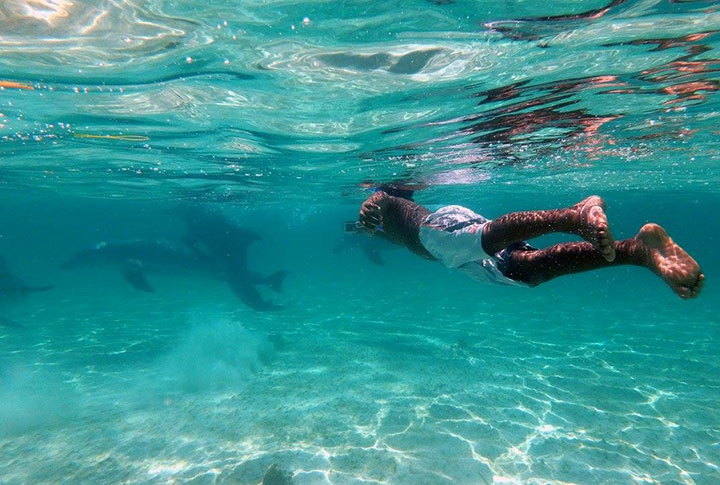|

|
 |
|
Last Updated: Feb 13, 2017 - 1:45:37 AM |

At risk – Environmentalists fear a proposed $200 million Carnival Cruise Water port could wipe out mangroves and marshlands, destroy untouched coral reefs, interrupt the purity of the watershed and alter the still breathtaking waters and beaches of East End, Grand Bahama. They urge the port be constructed in Freeport where the infrastructure to support it, including thousands of cruise passengers a week, already exists.
|
Two environmental organisations are calling on Carnival Cruise Lines to dry-dock plans to build a $200 million cruise port in East End, Grand Bahama, citing the area as “one of the most fragile and important ecological wonders of The Bahamas.”
Instead, say members of Save The Bays and Waterkeepers Bahamas, the port should be built in Freeport, where the infrastructure to support it already exists and where the economic environment would welcome it.
“We welcome Carnival Cruise Lines and recognize the importance of the cruise industry to the overall economy of The Bahamas,” said Joe Darville, Chairman of Save The Bays. “Our fear is that the very beauty that Carnival’s passengers and other visitors find in Grand Bahama could easily be destroyed if the port is built in that area. It is one of the most fragile and important ecological wonders of The Bahamas.”
Waterkeepers Bahamas Executive Director Rashema Ingraham said East End is a microcosm of all that makes the environment of The Bahamas “the amazing treasure” it is.
“Driving past the Casuarina Bridge and the new Jack Hayward Bridge into East End, a whole world opens up. There is nowhere else in The Bahamas quite like it, even the light is different. But it is very fragile and much of it is quite shallow or marshland. The campus of the College of The Bahamas (University of The Bahamas as of November 10) is on marshland.”
One of the greatest concerns, say both Darville and Ingraham, is the impact that such a port could have on the potable water source.
“Grand Bahama sits on one of the three greatest watersheds of The Bahamas, the others being Abaco and Andros,” explained Ingraham. “There is a reason that the storage tanks were located at East End. The water table extends for miles and if you allow salt intrusion through dredging you will be affecting the source of water for much of the northern Bahamas.”
Ingraham and Darville also note that East End beaches, including Gold Rock Beach, are the most desirable of all of Grand Bahama’s 80 miles of beach and coastline and may be the only place in The Bahamas where swimmers and snorkelers can swim among free dolphins who live and play in the waters less than two miles offshore. They also cite untouched coral reefs at Lightbourne Cay. Environmentalists and animal rights advocates have also voiced fears that the dolphins could be captured and kept in a confined area for swim with the dolphins’ experiences for cruise passengers to earn additional revenue for the cruise line.

Dolphins in the wild:
A young Bahamian swims with dolphins in the wild during Camp Eco-Explorer, Grand Bahama, this past summer. Environmentalists fear the pristine underwater world of the largely untouched area will forever be changed if a proposed $200 million Carnival Cruise Line port is approved.
|
“There is at present no infrastructure or amenities out east to support such a project,” said Darville, who chairs the 3-year-old organization that has more than 20,000 Facebook followers and whose petition has garnered nearly 7,000 signatures. “That whole area is also at basically sea level replenished with mangroves, flowing tidal creeks and other marine amenities, all of which will be destroyed by any such development.Why take a chance risking the loss of one of the great ecological treasures of The Bahamas when it can be moved just a matter of miles and create the same economic benefit without harming marine life, rare owls, a blue hole, the water supply, magnificent coral reefs, marshlands and an area where dolphins still swim free and in the wild?”
Environmentalist Sam Duncombe concurs.
“East End is also the site of the Lucayan National Park,” she said. “How can there even be consideration of a major cruise port in such a delicate low-lying area, with wide sand bank at low tide on one side, marsh and mangroves on the other, a small national park with historic value? It would be hard to imagine a less suitable place for a port.”
Duncombe, a board member of Save The Bays and founder of reEarth which played a significant role in preventing long-line fishing, said she does not believe there is any way an environmental impact assessment could recommend going forward with the port in the proposed location. Save The Bays and Waterkeepers, as well as re-Earth, also expressed concern about how an area so confined and fragile would handle the trash, packaging and garbage generated by cruise ships carrying thousands of passengers making weekly or more frequent stops.
Despite those concerns, the National Economic Council (NEC) last week gave the green light for the conclusion of a heads of agreement with Carnival Cruise Lines for the $200 million cruise project in East End. The government has said that such a port would have great economic impact.

© Copyright 2016 by thebahamasweekly.com
Top of Page
|
|
 |

|
